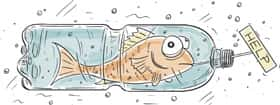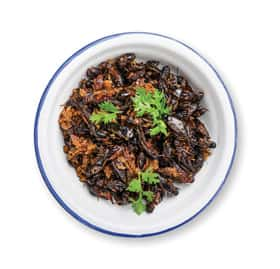Super Simple Ways to Be a Little Greener
Sure, you turn your office light off at night, recycle your soda cans and skip the plastic water bottles and drink tap water, but you know there’s more you can be doing. Eco-guilt is like that. Here are some super simple, totally doable, teeny tiny ways to be a bit greener.
1. Embrace Meatless Mondays. And maybe Tuesdays, too! Studies suggest that reducing your meat intake can slash your risk of chronic illnesses such as cancer, heart disease, diabetes and obesity. Plus, the meat industry generates nearly 20 percent of man-made greenhouse gas emissions, according to the United Nations’ Food and Agriculture.
2. Pop smarter. Microwave popcorn bags are lined with perfluorooactanoic acid (PFOA)—bad for the air and bad for you since studies show it may contribute to cancer and infertility. Instead, pop the old  fashioned way in a pan on the stove with a thin layer of canola oil.
fashioned way in a pan on the stove with a thin layer of canola oil.
3. Shop wisely. On average, we toss up to $43 in the form of about 20 pounds of food each month. Plan meals, use shopping lists, buy from bulk bins and avoid impulse buys.
4. Replace vinyl shower curtains. Swap out the vinyl for PVC-free plastic, cloth or bamboo. You’ll avoid more than 108 different chemicals vinyl emits into the air as well as that unpleasant plastic-y smell.
5. Go for a CFL-only home. Each compact fluorescent lightbulb (CFL) saves you about $6 per year in energy costs, according to Energy Star. And the Environmental Protection Agency reports that CFLs suck up to 75 percent less energy than incandescent light bulbs and last up to 10 times longer.
6. Skip the sink. Dishwashers use half the energy, one-sixth of the water, and less soap than handwashing, according to a German study. Just be sure it’s full before you run it. Doing so can save 100 pounds of carbon dioxide and $40 per year, according to the Environmental Protection Agency.
7. Let the video game console sleep. More than 40 percent of U.S. households have a video game console, and these devices consume nearly full levels of power even when turned off, costing you $50 to $100 per year. Look for the auto power off feature (Xbox 360 and PS have them) where the device automatically goes into a low-power sleep mode after a period of activity.
www.prevention.com
Strange But True
Q. As the Earth’s population continues to climb, a team of scientists and robots is raising about a million “six-legged livestock” a day hoping to supply much needed protein and other nutrients. What are these six-leggers?
A. They’re crickets, and they “pack more protein than beef, more calcium than milk, more iron than  spinach and as many fatty acids as salmon,” says Carl Engelking in Discover magazine. Once fully grown, they’re roasted and seasoned, then mixed into granola or ground into flour.
spinach and as many fatty acids as salmon,” says Carl Engelking in Discover magazine. Once fully grown, they’re roasted and seasoned, then mixed into granola or ground into flour.
To maximize yield, researchers need massive amounts of data, and crickets with their short (a few months) life span provide ample opportunity to amass this data from billions of cricket forebears. Feeder robots are employed to patrol bin aisles doling out specially designed formula. Currently, though, the 300,000 pounds of crickets produced at one next-gen facility are just a small fraction of the current human consumption of 8.8 billion pounds of whey powder a year.
Another research impetus is the stark contrast between beef and cricket production: Cows require 25 pounds of food for every pound of beef, while crickets need just two pounds of food for every edible pound they become. Further, the livestock industry contributes to greenhouse gas levels and drives deforestation. Says Engelking, “Insects are about as clean as it gets.”
Already, some 2 billion people regularly eat insects. It’s called entomophagy and will become, it is hoped, “an integral part of the world hunger solution.”
Source: Bill Sones and Rich Sones, Ph.D.
Have a Happy Merry Eco-Friendly Holiday
Help save the planet by making sustainable holiday choices this holiday season. When you save energy and resources, you protect the environment and safeguard health both now and in the future. Here are  some tips to make sustainable holiday choices this season.
some tips to make sustainable holiday choices this season.
Buy an artificial tree that you can use for years to come. Or, buy a living tree you can plant outside or keep as a houseplant after the holidays.
Use few or no lights in your holiday decorations. Or, use more energy efficient LED strings.
Decorate creatively and inexpensively. Use natural materials from your yard, or with items you already own.
Take your own bags on shopping trips. Keep them in the car so they’re always available.
Make your own gifts. Knit, sew, bake, build or create your own art. Make calendars with your own photographs, or a recipe book with your favorite recipes.
Send cards that are eco-friendly. Use the front of old cards as holiday post cards or gift tags.
Support your local economy. Buy from local merchants, craft shows or antique shops. And give in ways that support your community—tickets to local performances, concerts and sporting events. Or, gift certificates for massages, or a horseback riding adventure.
Donate to a charity or service organization. Make the donation in the name of a friend or relative that supports the cause.
Eat sustainably. Buy snacks and beverages in bulk to avoid extra packaging. Serve food with washable utensils, plates and glasses (rather than disposable products). Make homemade eggnog or hot chocolate in large quantities.
www.cdc.gov
Trashing the Season
 Americans throw away about 25 percent more trash between Thanksgiving and New Year’s Eve.
Americans throw away about 25 percent more trash between Thanksgiving and New Year’s Eve.
America could save enough paper to cover 45,000 football fields, if each family wrapped just three presents in reused materials.
About 35 percent of Americans have an unused Christmas gift collecting dust in their closets.
Hooked on Plastic
 The average American throws away approximately 185 pounds of plastic each year. In total, we toss out 35 billion plastic water bottles annually, according to Eco Watch.
The average American throws away approximately 185 pounds of plastic each year. In total, we toss out 35 billion plastic water bottles annually, according to Eco Watch.




